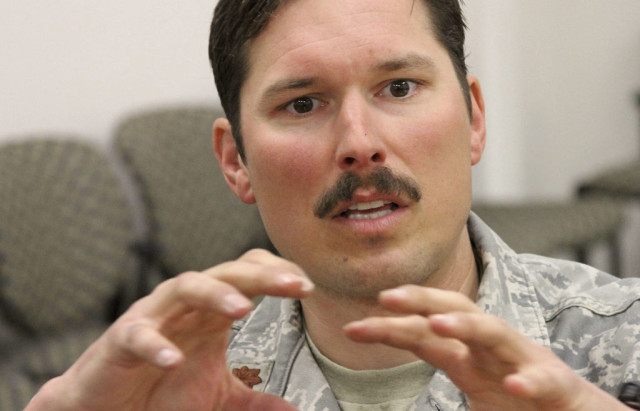ANCHORAGE, Alaska (AP) — An Alaska Air National Guard helicopter on Tuesday landed 50 meters from an orange blanket tied to a half-buried ski, hoping to find more signs of two people stranded for four nights on the vast Harding Ice Field.
Maj. Matthew Kirby and Master Sgt. Shane Hargis approached on snowshoes and spotted a tent pole sticking out from a hole the width of a soda can. They called out, and from 4 feet below the snow, Christopher Hanna and Jennifer Neyman shouted back.
The pole was maintaining a breathing hole to a snow cave.
A few minutes of digging by Hargis and Kirby allowed Hanna and Neyman to crawl out, soaking wet, hungry and suddenly happy.
“It was pretty cool how overjoyed they were,” Kirby said. “You can just feel the relief on everyone. OK, we got them. They’re OK.”
The ordeal began Friday when Hanna, 45, and Neyman, 36, both of Soldotna, Alaska, were dropped off by a small airplane for a day of recreation on the ice field. Foul weather prevented the plane from returning.
Harding Ice Field starts at an elevation of about 1,650 feet and covers 700 square miles. It’s a main feature of Kenai Fjords National Park.
“When you’re up there, it almost feels like it’s a desert made up of ice and snow,” said Deb Kurtz, physical science program manager for the park.
Moisture-laden air blows off the Gulf of Alaska, hits the mountain, cools and dumps up to four times the snow that falls at sea level.
By Friday night, Hanna and Neyman were in a blizzard. Heavy snowfall collapsed their tent.
“The snow literally crushed and buried their tent three feet down, three to four feet down,” Kirby said.
A snow cave was their only hope.
Snow caves provide shelter from wind and capture heat given off bodies of people inside.
As Neyman held up the tent ceiling, Hanna dug outside the door in older, harder snow, below the tent, Kirby said.
The cave was perhaps 7-by-5 feet and 3-4 feet high, Kirby said. The skiers used the tent pole to maintain the breathing hole but the cave would not have endured much additional snowfall, he said.
“They were running out of pole,” he said.
Hanna carried a personal locator beacon with texting capability. His messages to a friend set the rescue in motion. The device also gave rescuers their exact coordinates.
Air Guard helicopters Monday could not reach the ice field but dropped off a four-man personnel recovery team 15 miles away. Hammered by cross winds up to 35 mph, moving up a glacier in whiteout conditions, maneuvering with instruments and probing for crevasses, they skied nine miles uphill until halting late in the evening, said Maj. Brock Roden. They were perhaps 90 minutes away the next morning when a helicopter was able to land.
The problem for landing was not the gusting winds, said pilot Kevin Kelly, but the flat, morning light that made it difficult to distinguish sky from snow.
A flight engineer, Master Sgt. Edward Downs, spotted the orange blanket about 8 a.m., but blowing snow quickly blocked it from view. The helicopter refueled and waited near a glacier for clouds to clear.
Crewmen brought along spruce boughs that could be dropped onto the snow and used as a landing reference point.
By noon they didn’t need them. The helicopter swooped to where the skis marked the snow cave.
“If we hadn’t gotten to them, they were slowly starving, dehydrating, trending toward a bad place,” Kirby said. “But fortunately we were able to get there and pull them out.”
___
This story has been corrected to show the breathing hole was maintained with a tent pole, not a ski pole.

COMMENTS
Please let us know if you're having issues with commenting.